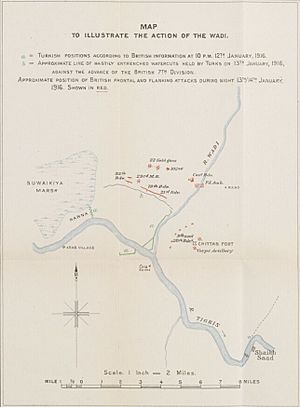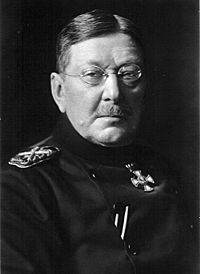Battle of Wadi (1916) facts for kids
Quick facts for kids Battle of Wadi |
|||||||
|---|---|---|---|---|---|---|---|
| Part of the Mesopotamian campaign of World War I | |||||||
 A 1924 British map showing action at the Wadi |
|||||||
|
|||||||
| Belligerents | |||||||
|
|||||||
| Commanders and leaders | |||||||
| Strength | |||||||
| 19,000 | 20,000 | ||||||
| Casualties and losses | |||||||
| 1,600 dead or wounded, numerous captured |
527 casualties unknown, estimated minor | ||||||
The Battle of Wadi happened on January 13, 1916. It was part of World War I in a region called Mesopotamia, which is now Iraq. British forces tried to rescue their friends who were trapped in a city called Kut-al-Amara. The Ottoman Empire's army had surrounded them.
The British commander, Sir John Nixon, wanted an attack. General Fenton Aylmer led the British troops. They attacked Ottoman defenses near the Wadi River. The Wadi was a deep valley. It ran into the River Tigris.
The attack did not go well for the British. They did capture the Wadi valley. But they lost about 1,600 soldiers. This battle was a big part of why the British failed to help their trapped army. Later, 10,000 British soldiers had to surrender at Kut. This was the biggest surrender of British troops at that time. However, the British later took Kut back in February 1917. They then captured Baghdad in March 1917.
Contents
Why the Battle Happened: The Siege of Kut
In December 1915, Ottoman forces surrounded a British-Indian army. This army had about 25,000 soldiers. They were trapped in the city of Kut-al-Amara. This event is known as the Siege of Kut. The Ottoman commanders were Halil Kut and German general Baron von der Goltz.
Major Charles Townshend was the British commander trapped in Kut. He asked for help. Sir John Nixon sent a relief force. This force was called the British Tigris Corps. It had 19,000 men. Lieutenant General Sir Fenton Aylmer led them. Their mission was to free the trapped soldiers.
The first rescue attempt was on January 6, 1916. This was the Battle of Sheikh Sa'ad. General George Younghusband led the British advance. They met the Ottomans near Sheikh Sa'ad. The British could not defeat the Ottomans there. They lost many soldiers, about 4,202. After this, the Ottomans moved back. They went about 10 miles (16 km) upstream to the Wadi River.
Getting Ready for the Fight
Aylmer's troops were very tired. They were also losing hope. They kept moving up the Tigris River towards Kut. It was hard to move supplies. There were not enough good roads.
General Aylmer planned to go around the Ottoman defenses. He wanted to capture the Hanna Defile. This would surround the Ottoman army. The 28th Indian Brigade would attack the Wadi trenches from the front. The rest of the British army would go around the side. But the British did not have good maps. So, much of the plan was left to chance.
Meanwhile, the Ottoman army got ready. Their new commander was Halil Pasha. They built strong defenses. They had about 20,000 soldiers. They were along the banks of the smaller Wadi River. The British would have to cross this river to reach Kut.
The Battle of Wadi Begins
The attack started in the afternoon of January 13. It was supposed to begin in the morning. But a thick mist and slow-moving artillery caused delays. This meant the British lost their chance to surprise the Ottomans.
The British forces were outnumbered. They struggled against the strong Ottoman defense. General Kemball led the frontal attack. General Younghusband tried a wide move around the side. The delay hurt their chances. Ottoman guns and rifles began to stop the British soldiers.
The leading British group got lost. They did not have good maps. The Ottoman units saw this chance. They changed their positions to face the British. The frontal attack by the 28th Brigade was pushed back. Many British soldiers were hurt.
By evening, it was clear the attack had failed. British troops could not get around the Ottoman sides. The entrance to the Hanna Defile was still held strongly by the Ottomans. Aylmer stopped the attack by the end of the day. He moved most of his soldiers to the other side of the Tigris River.
Aylmer's troops did gain control of the Wadi. But it was a small gain. It was not worth the 1,600 soldiers killed or wounded. This included 40 British officers. The medical help was still very bad. Many wounded soldiers suffered for days without care.
What Happened Next

The British tried to break through the Ottoman lines for months. They wanted to rescue their friends in Kut. But all their attempts failed. In April 1916, after almost five months, Townshend and 10,000 of his men surrendered. This was the largest surrender of British troops ever at that time.
Many British prisoners faced harsh conditions. They lacked food and proper care. Nearly 5,000 of them died before the war ended. The Siege of Kut was a big victory for the Ottomans. It made their soldiers feel very proud. It also raised the Ottoman Army's standing in the Middle East. The British government had to send more resources to Mesopotamia.
The British did capture Kut in February 1917. This was on their way to taking Baghdad. They captured Baghdad sixteen days later, on March 11, 1917. This helped make up for the earlier loss of Kut. The Ottoman government had to stop its military actions in Persia. They tried to build a new army. They wanted to stop the British from moving on to capture Mosul.
Sepoy Chatta Singh was a soldier from the 9th Bhopal Infantry. He received the Victoria Cross for his brave actions in this battle.
Images for kids


